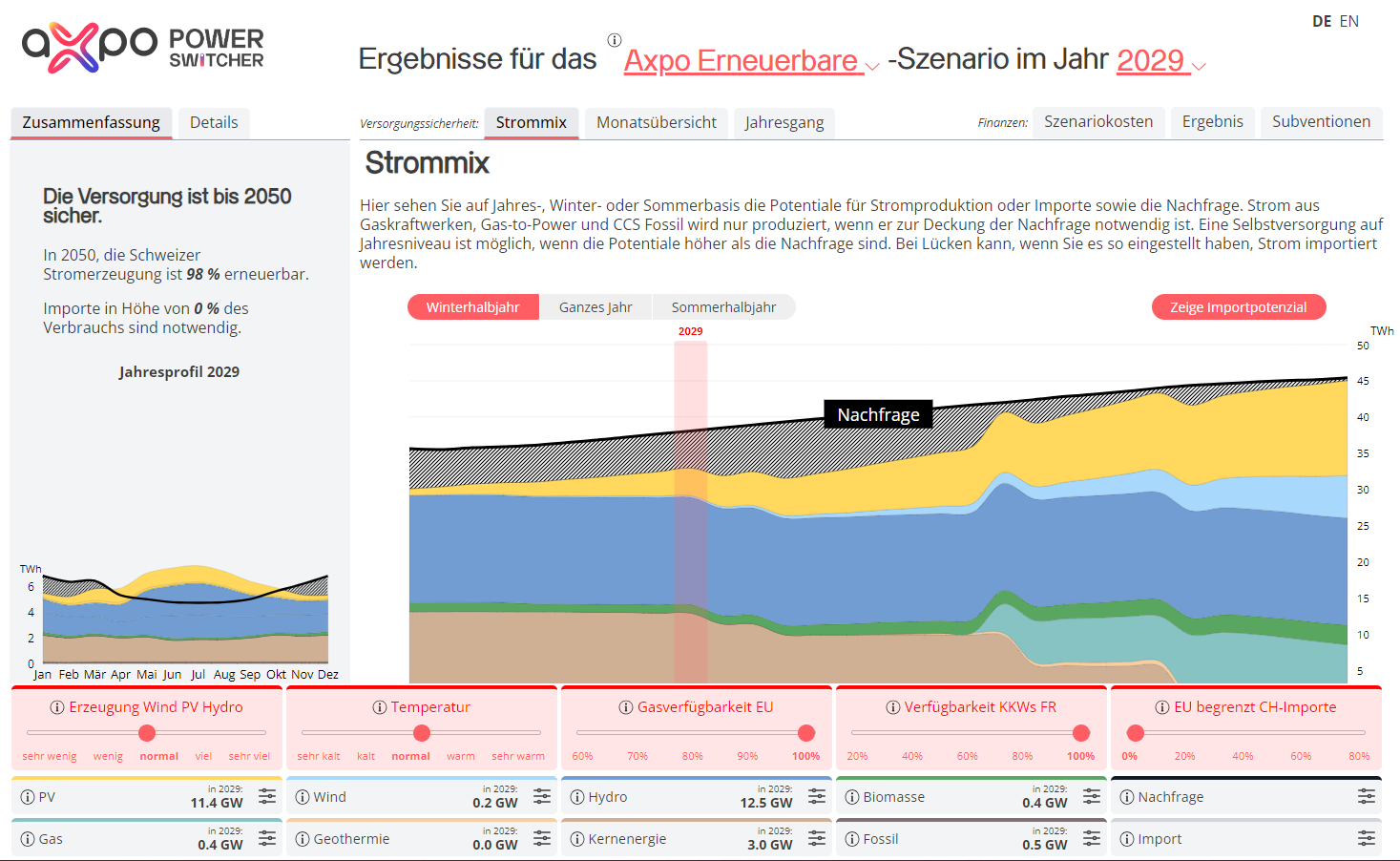29.11.2023 | Security of supply? We take care of it – today with Roman von Siebenthal
Secure power supply impossible without trade

The Asset-Backed Trading department, headed by Roman von Siebenthal, determines which of Axpo's Swiss power plants is in operation and when. It also ensures that the reservoirs in the mountains are always optimally utilised.
The demand for electricity rises sharply with very little notice. The sluices of the Limmern pumped storage power plant are opened. Huge volumes of water flow over the turbines, which weigh several tonnes and in turn drive the generators, thereby producing the electricity needed to cover the additional demand immediately.
The people who set the pace for when and how the power plant high up in the Glarus Alps is used – Roman von Siebenthal, Head of Spot & Forward Trading, and his 19-strong team – are, however, based three and a half hours away by car, in Axpo's trading rooms in Baden. They are supported by almost as many specialists, who model and optimise the deployment plan for the power plants. The actual start or stop command to start up or shut down a plant is the responsibility of colleagues in Dispatching.
But why is the decision whether or not to deploy made by the Asset-Backed Trading team? "We market the entire portfolio of our Swiss plants, including the power plants in which we hold a stake. We develop and are therefore familiar with the overall plans for their use, which we are also continually refining. Furthermore, the relevant information from the national and international markets is collated in our Trading department," explains Roman.
The task of Asset-Backed Trading is basically to anticipate price signals from the markets, forecast consumer load, and make efficient use of the company's own power plants accordingly.
Determining optimal power plant deployment is challenging and is optimised on a daily basis. It is based on price curves for various markets and commodities, such as electricity and natural gas, as well as on weather forecasts and technical constraints. All the factors that influence the price of electricity and the power plants must be constantly taken into consideration and unforeseen events and risks must be anticipated.
The weather factor...
Switzerland is integrated within the European electricity market, where the restructuring of the energy system – away from fossil fuels and towards volatile solar and wind power – has been strongly promoted in recent years. This has significantly increased complexity on the supply side and caused the flow of market data to increase enormously. After all, uncertainty is inevitable, especially when the weather is involved. Without custom-made models and tools, on the one hand, and clever, talented and experienced minds, on the other, these challenges cannot be mastered successfully.
Roman has worked in energy trading for over two decades and has been with Axpo since 2009. "It's a great job," says Roman, who in his youth taught primary school children and most likely inspired their curiosity as to what holds the world together on the inside. He initially wanted to study philosophy, but in the end he decided in favour of mathematics, remaining true to his sense of logic and creativity.
Water storage: unbeatably effective
Together with his team, Roman is responsible for trading the annual energy volume of around 24 terawatt hours from Axpo and partner power plants in Switzerland, as well as for long-term energy supply contracts with other countries. The centrepiece is the hydropower portfolio with 24 reservoirs, 32 equalisation basins, 130 turbines, 6 pumps, 17 pump turbines and 4 regulated turbines.
This portfolio needs to be brought to market. Electricity supply and demand in the European market, including Switzerland, must always be balanced so that the electricity supply does not collapse. Agreed outflows and inflows of electricity must therefore always take place on time and in full.
There are basically two types of power plant in the Axpo portfolio in Switzerland: those that either cannot be controlled or can only be controlled to a limited extent, for example the Rüchlig run-of-river power plant and the Beznau nuclear power plant, and those that can be flexibly controlled, such as the Limmern pumped storage power plant – a battery with a capacity of 1,000 megawatts. "These power plants can store huge amounts of energy efficiently. The pumping efficiency of such modern systems amounts to over 80 per cent. Unbeatable!" says Roman enthusiastically: "The perfect complement to stochastic solar and wind energy"
Well-filled reservoirs
In the short term, market prices signal whether stored water should be released through turbines from the storage reservoirs or not. However, the further into the future it is necessary to look, the less information is available. For example, will we have enough water in February from today's perspective? No (weather) model has a sufficiently precise answer to this question. Although the reservoirs are currently still almost full, we cannot know today whether we will have enough water for the whole winter. There are too many uncertainties: the weather alone can only be forecast reasonably reliably for a few days. This is what makes the "view of the tank", as Roman says, so important: "A Porsche may have a lot of power, but it won't get very far on an empty tank. Our entire power plant portfolio also has a lot of capacity. But our "tank" in the mountains, the storage power of the water, is not enough to keep us going all winter long."
This is why the responsible use of the valuable resource of stored water is so important. "Instead of relying solely on today's market opinion, we build in safety margins so that we are also prepared for unexpected developments. We've always succeeded in this so far, and we're doing everything we can to ensure that we succeed tomorrow and the day after as well," says Roman.
Balancing fluctuations – hedging risks
Balancing fluctuations – hedging risks
Trading takes place on the spot and futures market. Electricity is traded at short notice on the spot market (spot trading). This enables Axpo to compensate for or optimise fluctuations in consumption. The company also knows roughly how much electricity its own power plant fleet can produce in the medium term. Naturally, however, it is not possible to know the spot price that will be paid for a specific amount of electricity in the future. This constitutes a considerable risk for Axpo as an electricity producer, but also for the buyers, for example a large consumer or a distribution system operator with many end customers. Hence Axpo hedges parts of its production in the futures market (forward trading) thereby creating liquidity in the futures market, which consumers use to hedge their own risk.




.jpg)





